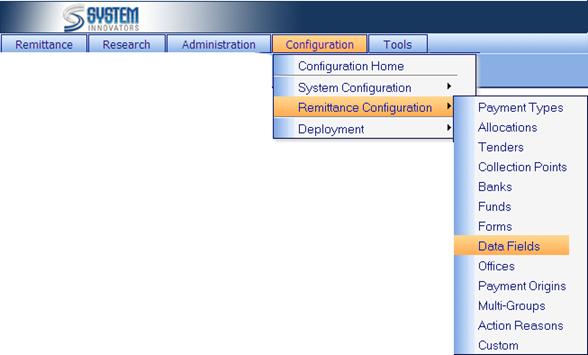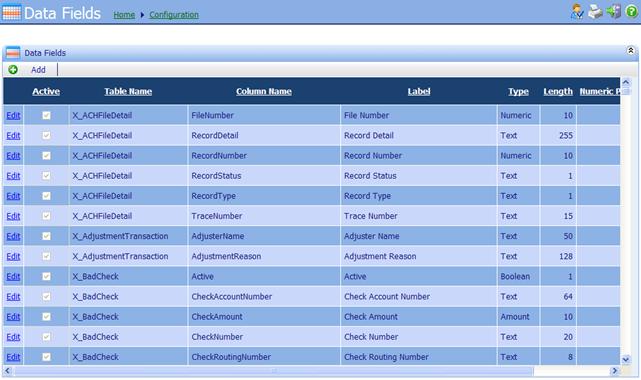
A Data
Field acts as a placeholder for data in the payment database. Each Data Field
is associated with a data column in a particular table within the database.
Data fields may be placed on Forms (such as a Receipt Form or an Endorsement Form.)
A
Data Field can be either Active or Inactive.†
A Data Field cannot be deleted. If a Data Field is no longer needed,
make the Data Field Inactive.
There
are two main categories of Data Fields within the iNovah database:
System Fields: these fields have been
created by iNovah developers and engineers and are critical to the successful
operation of iNovah. As such, they are unable to be edited or deleted by IT
personal. Fields which fall under this category reside in the following data
tables owned by the system. Tables not editable include:
∑
X_ACHFileDetail
∑
X_AdjustmentTransaction
∑
X_BankDeposit
∑
X_BankDepositDetail
∑
X_Payment
∑
X_PaymentAllocation
∑
X_PaymentBatch
∑
X_PaymentBatchAction
∑
X_PaymentBatchStatus
∑
X_PaymentStatus
∑
X_Tender
∑
X_TenderACH
∑
X_TenderACHStatus
∑
X_TenderCardInfo
∑
X_Transaction
Custom
Fields: These fields are able to be created by IT personnel
to assist in the collection and storing of payment related information. As
such, they may be added and edited but not deleted. They are tied to payment
transactions so deleting these fields would interfere with the accounting,
reporting, and storage procedures of iNovah. All payment collection data fields
created reside in the X_PaymentCustom table. Data fields created by IT
personnel will appear in the Payment Form Editor along with system fields which
are defined for payment transactions. When developing and choosing which fields
to use it is always best to first use system data fields before creating a
custom field.
∑
X_PaymentCustom
The
Data Fields page is located at Configuration>Remittance
Configuration>Data Fields.

(Example of
the Data Fields page)

(Options for
the Data Fields page)
|
|
Add
a Data Field. |
|
Edit |
Edit
a Data Field. |
Related Topics
Configuration
How To: Add a new Data Field